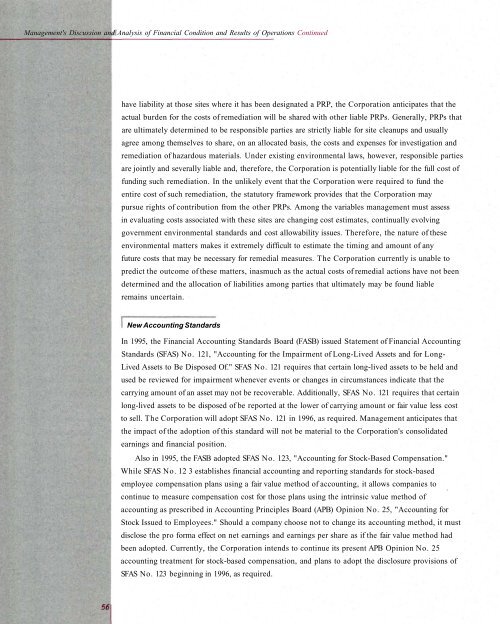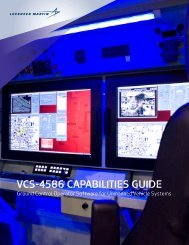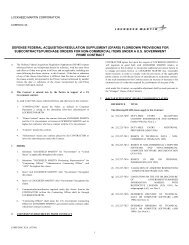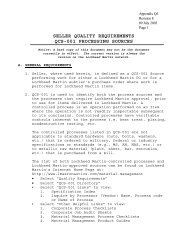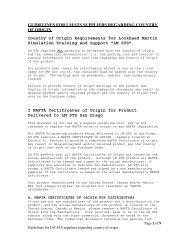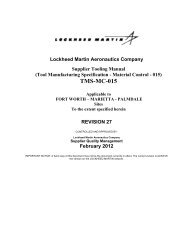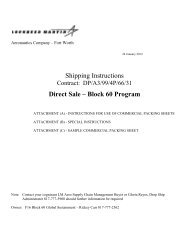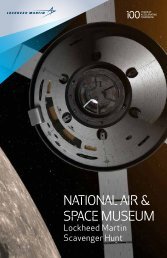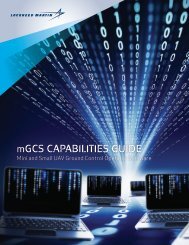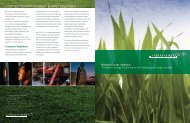Management's Discussion and Analysis of Financial Condition and Results of Operations Continuedhave liability at those sites where it has been designated a PRP, the Corporation anticipates that theactual burden for the costs of remediation will be shared with other liable PRPs. Generally, PRPs thatare ultimately determined to be responsible parties are strictly liable for site cleanups and usuallyagree among themselves to share, on an allocated basis, the costs and expenses for investigation andremediation of hazardous materials. Under existing environmental laws, however, responsible partiesare jointly and severally liable and, therefore, the Corporation is potentially liable for the full cost offunding such remediation. In the unlikely event that the Corporation were required to fund theentire cost of such remediation, the statutory framework provides that the Corporation maypursue rights of contribution from the other PRPs. Among the variables management must assessin evaluating costs associated with these sites are changing cost estimates, continually evolvinggovernment environmental standards and cost allowability issues. Therefore, the nature of theseenvironmental matters makes it extremely difficult to estimate the timing and amount of anyfuture costs that may be necessary for remedial measures. The Corporation currently is unable topredict the outcome of these matters, inasmuch as the actual costs of remedial actions have not beendetermined and the allocation of liabilities among parties that ultimately may be found liableremains uncertain.New Accounting StandardsIn <strong>1995</strong>, the Financial Accounting Standards Board (FASB) issued Statement of Financial AccountingStandards (SFAS) No. 121, "Accounting for the Impairment of Long-Lived Assets and for Long-Lived Assets to Be Disposed Of." SFAS No. 121 requires that certain long-lived assets to be held andused be reviewed for impairment whenever events or changes in circumstances indicate that thecarrying amount of an asset may not be recoverable. Additionally, SFAS No. 121 requires that certainlong-lived assets to be disposed of be reported at the lower of carrying amount or fair value less costto sell. The Corporation will adopt SFAS No. 121 in 1996, as required. Management anticipates thatthe impact of the adoption of this standard will not be material to the Corporation's consolidatedearnings and financial position.Also in <strong>1995</strong>, the FASB adopted SFAS No. 123, "Accounting for Stock-Based Compensation."While SFAS No. 12 3 establishes financial accounting and reporting standards for stock-basedemployee compensation plans using a fair value method of accounting, it allows companies tocontinue to measure compensation cost for those plans using the intrinsic value method ofaccounting as prescribed in Accounting Principles Board (APB) Opinion No. 25, "Accounting forStock Issued to Employees." Should a company choose not to change its accounting method, it mustdisclose the pro forma effect on net earnings and earnings per share as if the fair value method hadbeen adopted. Currently, the Corporation intends to continue its present APB Opinion No. 25accounting treatment for stock-based compensation, and plans to adopt the disclosure provisions ofSFAS No. 123 beginning in 1996, as required.
<strong>Lockheed</strong> <strong>Martin</strong> CorporationT h e C o r p o r a t i o n ' s R e s p o n s i b i l i t yf o r F i n a n c i a l R e p o r t i n gThe management of <strong>Lockheed</strong> <strong>Martin</strong> Corporation prepared and is responsible for the consolidated financial statements and all relatedfinancial information contained in this report. The consolidated financial statements, which include amounts based on estimates andjudgments, have been prepared in accordance with generally accepted accounting principles applied on a consistent basis.The Corporation maintains a system of internal accounting controls designed and intended to provide reasonable assurance that assetsare safeguarded, transactions are properly executed and recorded in accordance with management's authorization, and accountability forassets is maintained. An environment that establishes an appropriate level of control consciousness is maintained and monitored and includesexaminations by an internal audit staff and by the independent auditors in connection with their annual audit.The Corporation's management recognizes its responsibility to foster a strong ethical climate. Management has issued written policystatements which document the Corporation's business code of ethics. The importance of ethical behavior is regularly communicated to allemployees through the distribution of written codes of ethics and standards of business conduct and through ongoing education and reviewprograms designed to create a strong compliance environment.The Audit and Ethics Committee of the Board of Directors is composed of eight outside directors. This Committee meets periodicallywith the independent auditors, internal auditors and management to review their activities.The consolidated financial statements have been audited by Ernst & Young LLP, independent auditors, whose report follows.Marcus C. BennettSenior Vice President and Chief Financial OfficerRobert E. RulonVice President and ControllerR e p o r t o f E r n s t & Y o u n g L L P ,I n d e p e n d e n t A u d i t o r sBoard of Directors and Stockholders<strong>Lockheed</strong> <strong>Martin</strong> CorporationWe have audited the accompanying consolidated balance sheet of <strong>Lockheed</strong> <strong>Martin</strong> Corporation as of December 31, <strong>1995</strong> and 1994,and the related consolidated statements of earnings, stockholders' equity, and cash flows for each of the three years in the period endedDecember 31, <strong>1995</strong>. These financial statements are the responsibility of the Corporation's management. Our responsibility is to express anopinion on these financial statements based on our audits.We conducted our audits in accordance with generally accepted auditing standards. Those standards require that we plan and performthe audit to obtain reasonable assurance about whether the financial statements are free of material misstatement. An audit includesexamining, on a test basis, evidence supporting the amounts and disclosures in the financial statements. An audit also includes assessing theaccounting principles used and significant estimates made by management, as well as evaluating the overall financial statement presentation.We believe that our audits provide a reasonable basis for our opinion.In our opinion, the consolidated financial statements referred to above present fairly, in all material respects, the consolidated financialposition of <strong>Lockheed</strong> <strong>Martin</strong> Corporation at December 31, <strong>1995</strong> and 1994, and the consolidated results of its operations and its cash flowsfor each of the three years in the period ended December 31, <strong>1995</strong>, in conformity with generally accepted accounting principles.The Corporation changed its method of accounting for the Employee Stock Ownership Plan effective January 1, 1994 as discussed inNote 1 to the consolidated financial statements.Washington, D.C.January 23, 199657


